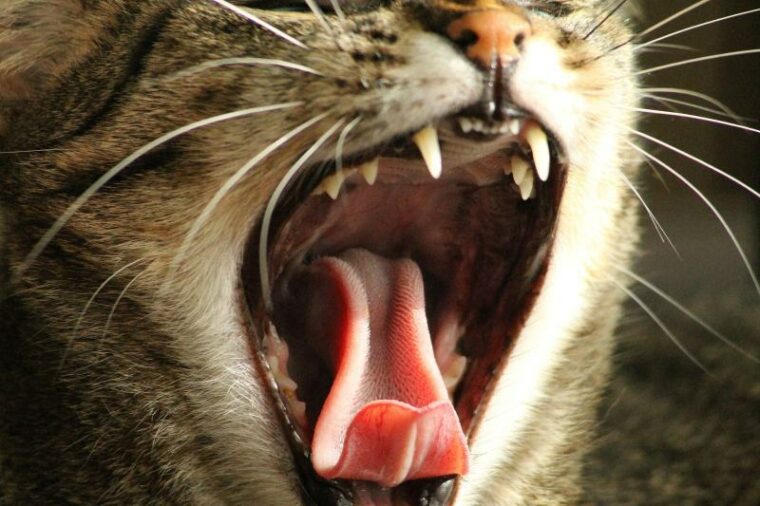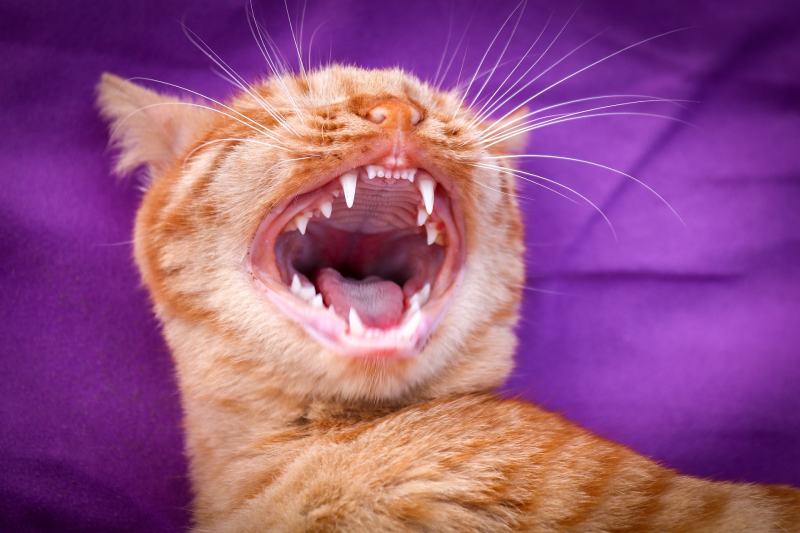
As larger felines found in the wild are considered apex predators, it is probably hard to imagine that your soft, cuddly pet cat comes from that same family of predators. Though one thing that may hint at their predatory roots is inside their mouth, as their sharp teeth are an unmistakable characteristic that ties them to those same wild cats at the top of the food chain.
Here, we discuss 10 fun facts about your cat’s teeth.
The 10 Most Fascinating Facts About Cats’ Teeth
1. Cat teeth are similar to human teeth.
At first glance, cat and human teeth differ greatly in appearance. Human and cat teeth, however, are similar in the sense that they both get “baby” and “adult” teeth!
Cats and humans are both diphyodont animals—meaning they each have two successive sets of teeth. You probably remember the excitement of losing your baby teeth and eventually watching your adult teeth set in. Well, cats have two sets too! The first set of teeth, or the deciduous teeth, fall out before the permanent adult set comes in.
As we have different lifespans, the timeline of tooth development differs between cats and humans. Starting toothless at birth, cats start to grow their baby teeth at 2 weeks old. These teeth begin to fall out at around 3 months old, making way for their permanent adult teeth.
Cats typically develop 26 baby teeth before growing a full set of 30 adult teeth—with 16 in the upper jaw, and 14 in the lower jaw.
2. Cats’ teeth are built for hunting.

First, we talked about the similarities between cat and human teeth. Moving forward, we will dive into the differences, and what makes cats’ teeth unique.
The first thing you will notice about cat teeth is that they are extremely sharp. Their crown-shaped teeth are characteristic of the feline family’s predatory lineage. Being obligate carnivores like their cousins in the wild, cats’ teeth are designed for tearing meat, and are sharp enough to puncture the skin of their prey.
This makes even the most playful of kitty bites painful!
3. Cats cannot chew their food.
With all those sharp teeth specifically designed for shearing the toughest of meats, cats technically cannot chew their food. Unlike humans and other mammals who have flat molars designed to crush food during mastication, cats’ molars are sharper and poorly designed for crushing but optimally designed for shearing and tearing. This makes cats’ version of “chewing” a little different from humans. When eating, cats basically cut up the food in their mouths instead of crushing them prior to swallowing it!
4. Cats’ jaws only move up and down.

Another fact about how cats eat their food involves the limited range of motion of their jaw—which is limited to mainly up and down.
When humans chew, the jaw moves in a circular motion, allowing the molars to crush the food on the flat surface of the tooth. For cats, however, this up and down jaw motion for “chewing” complements the shape of their teeth, as they are specifically designed for tearing rather than crushing.
5. Cats have different teeth with different functions.
Cats have 4 different types of teeth, each with their own specific function—the canines, incisors, premolars, and molars.
The canines, otherwise known as the fangs, are the most notable among the teeth when looking inside a cat’s mouth. These are primarily designed for puncturing the skin of prey when hunting.
The set of teeth in between the canines are called the incisors, which are mainly used for picking up objects, as well as help with grooming.
The premolars and molars are the teeth behind the canines and are used to cut and grind the food when eating.
6. Cats do not get cavities.
Cats do not develop cavities due to the shape of their teeth, as well as the fact that their diet does not typically cause cavities in the first place.
With cat teeth having a sharper shape than the flatter teeth of humans, cats do not develop cavities the way humans do. Cavities develop on the horizontal surface of teeth—called occlusal tables—which are not found in cat teeth. Simply put, the geometry of the teeth gives bacteria a different type of surface area to stick to and their diet doesn’t contain many sugars to feed the bacteria.
7. Cats are prone to a variety of dental issues.

Although unable to develop cavities, cats are still susceptible to several dental complications. Dental conditions commonly experienced by cats include:
Symptoms of these diseases are best detected through observation of the oral and dental structures. Take your cat for a check up at the vet if you have any concerns about dental health.
8. Cats rarely show tooth pain.
Cats are known to hide their pain. Being both predator and prey by nature, they are unlikely to show any signs of weakness, such as pain and discomfort—making it difficult to identify symptoms of dental pain unless proactively search for them through visual observation of the mouth.
With this idea in mind, it is important to proactively look for signs of complications, such as drooling, redness in the gums, broken or missing teeth, or changes in behavior. Like most diseases, early detection is essential to ensure your cat gets immediate treatment before the condition gets any worse.
9. Cats can eat even without teeth.
Being on top of a cat’s dental care can prevent any loss of teeth. But for some instances, this may be unavoidable, and your cat may lose a tooth or two.
In the wild, cats’ teeth are essential for devouring prey. Therefore, losing teeth can put a cat at risk, as they may be unable to hunt for food. Domesticated cats, however, can survive without teeth, as they have no need to hunt for their prey. They can still manage to eat wet foods and eventually move on to dry foods, such as kibble and meat even after losing a few, or even all their teeth!
10. Cat teeth require dental care – some helpful tips for protecting your cats’ teeth!
As mentioned earlier, cats are prone to numerous dental issues, many of which can easily go unnoticed. With that said routine dental care is recommended to ensure your cat has healthy teeth to prevent any diseases from occurring.
The beginning of any oral and dental health routine begins with diet. A balanced diet, combined with a home pet dental care routine, can go a long way for your cat’s oral hygiene. The VOHC (Veterinary Oral Health Council) examines studies on cat foods, treats, and dental care products to ensure they are safe and effective. Look for the logo or check their list of approved products.
Cats are known to be very particular about their personal space, so going near their mouth for dental care may seem like a difficult task. A simple routine for dental care with a toothbrush and toothpaste specifically designed for cats is enough in between veterinary visits. It is important to accustom your cat at a young age to the toothbrush through positive training.
There are also dental chews that can be added to their dry food diet to help maintain their tooth health.
Routine veterinary visits are also recommended. Like humans who go to the dentist for dental care, your cat should also undergo an oral examination every year on a visit to the veterinary clinic. Your cat may have to undergo dental cleaning, or they may detect a dental disease that needs prompt treatment that has otherwise been going under the radar at home.
Conclusion
As cat parents, it is our responsibility to monitor our cats’ dental care. Cats refuse to show weakness and pain, making it difficult to detect any dental complications. Routine dental care at home and at the veterinary clinic is important for ensuring our fur babies are healthy from fang to tail.
Featured Image Credit: vargazs, Pixabay








